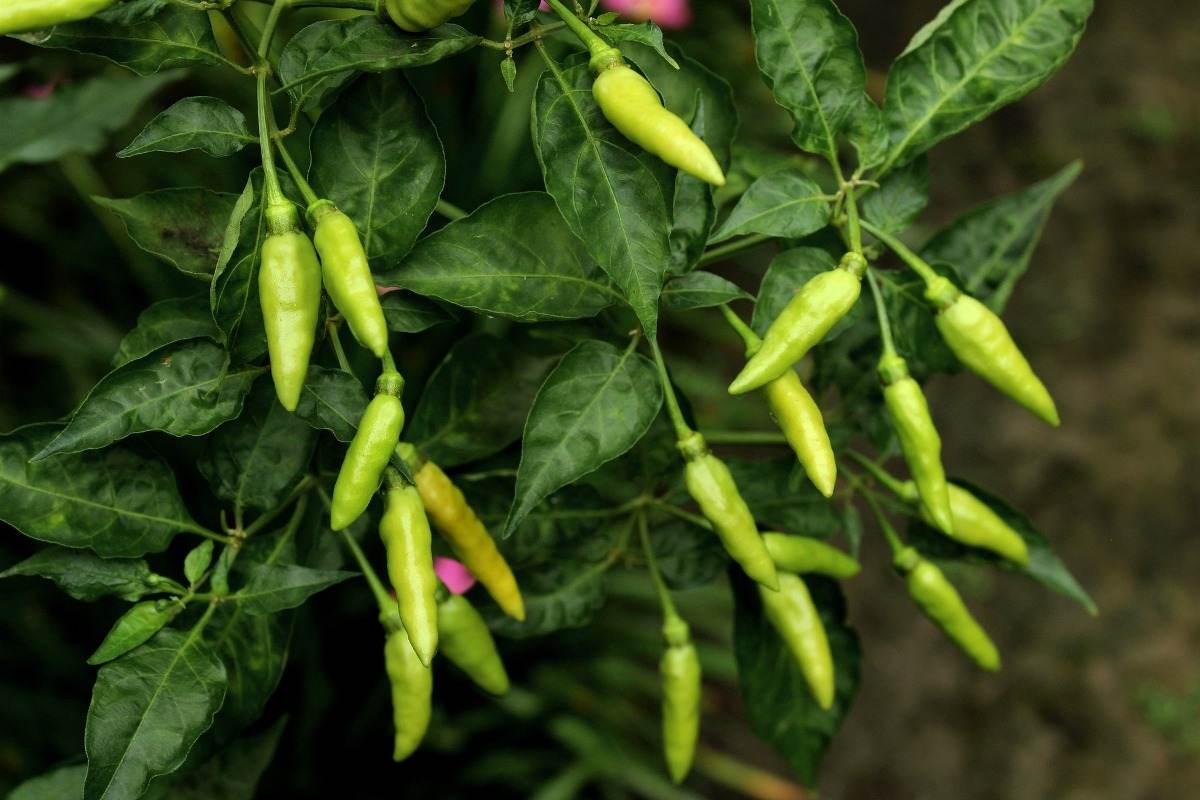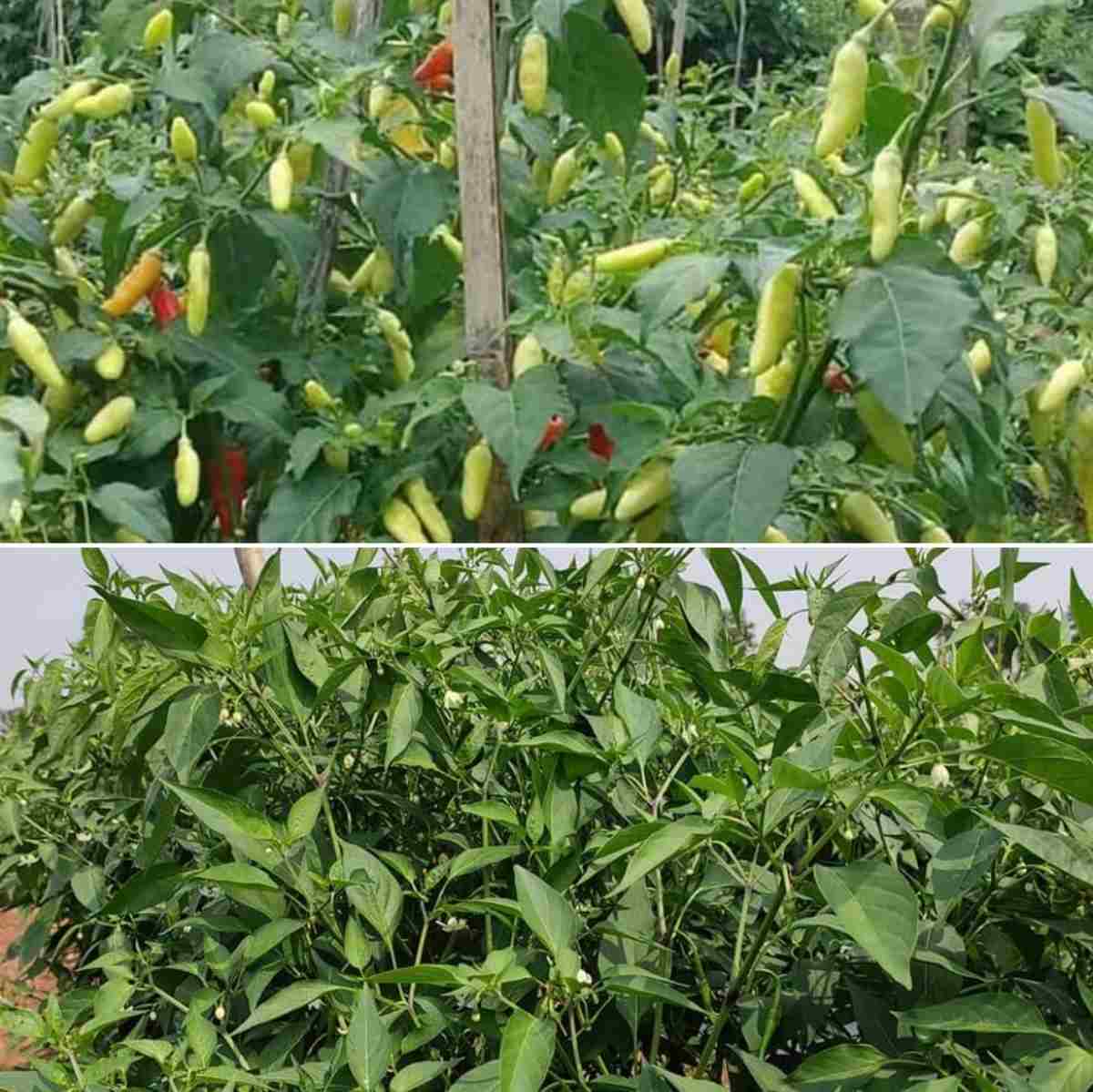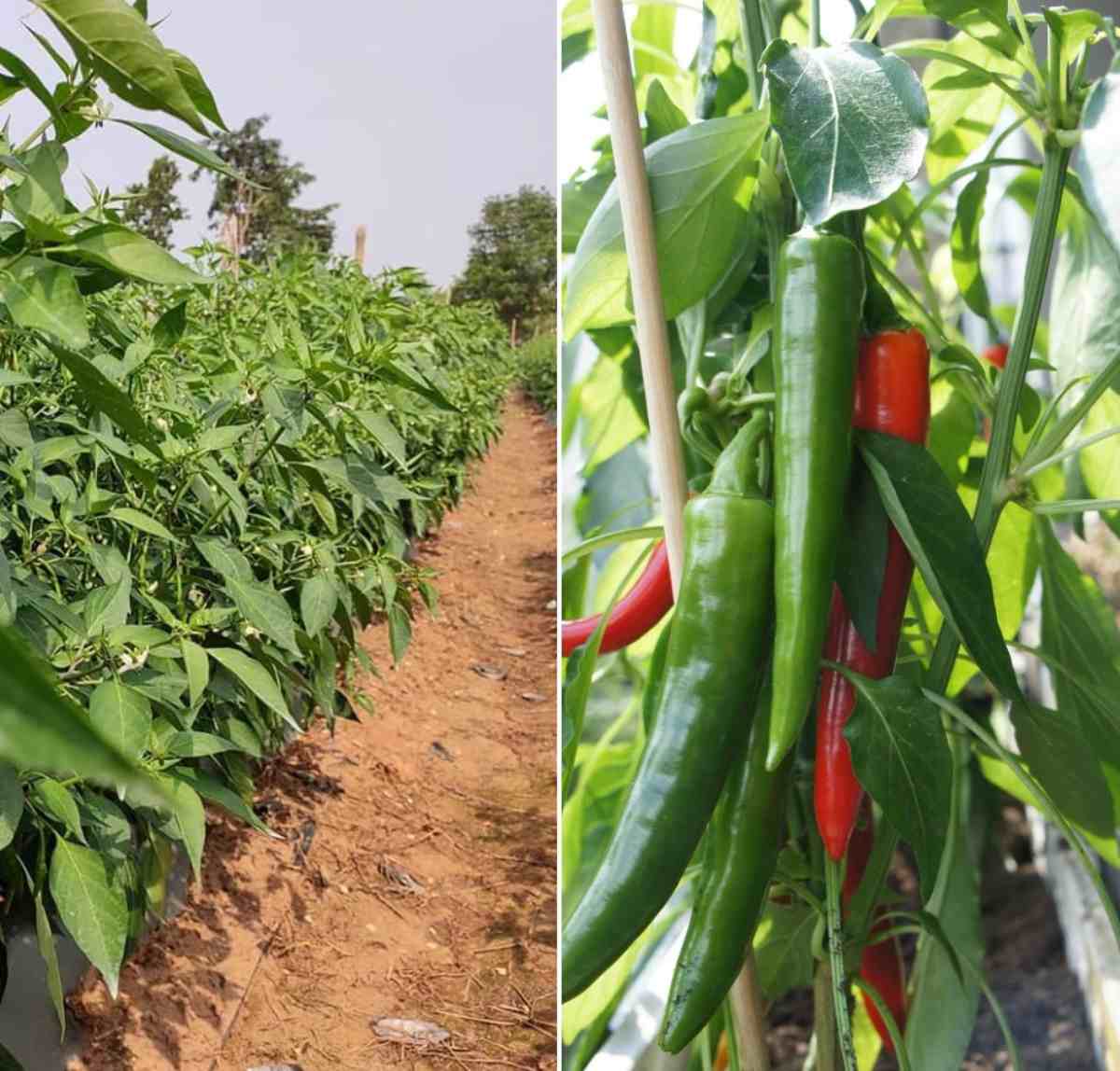Introduction to Chilli flower drop
Chilli is also known as Chilli pepper, is one of the most valuable spice crops. Chilli is a spicy fruit used in cuisine preparations. It is added as an ingredient in foods to make the preparation spicy. Indian Chillies especially the ones grown in the Guntur district of Andhra Pradesh are known for their pungency and also color. Some of the big-sized Chillies are called bell peppers and used as a vegetable.
Chilli belonging to family Solanaceae, it is botanically called Capsicum annuum. Chilli is a small, annual shrub with an erect, branched shoot. The Chilli flowers are small, white, and are pendent. In other words, unlike in other plants the Chilli flowers droop down and hang like pendants. The Chilli fruits also similarly hang downwards. Chilli plant seeds are contained within the fruit. Flowering time in Chilli that means days required for flowering in Chilli crop depends upon the cultivar, temperature, light intensity, duration, soil fertility, soil moisture, and the age of seedlings at transplantation.
A step by step guide to Chilli flower drop, reasons, prevention

Different varieties of Chilli
Some of the varieties of Chilli can be given below;
- Bird’s eye Chilli (dhani)
- Byadagi (kaddi)
- Ellachipur sannam-s4 type
- Guntur sannam-s4 type
- Hindpur-s7
- Jwala
- Kanthari-white
- Kashmir Chilli
Some of the hybrid Chilli varieties are;
CO.1 – Fruits are long, bright red. Yields about 2.10 tonnes/ha of a dry pod in a crop duration of about 210 days. Fruits have high capsaicin content about 0.72mg/g.
CO.2 – Selection from Nambiyur local ‘Gundu type’ and fruits are thick and red with high seed content and pungency. Harvested for both green and red ripe pods Yields about 2.20 tonnes/ha of a dry pod in a crop duration of about 210 days.
CO.3 – Plants suitable for close planting (30 x 15 cm) and less affected by heavy wind. Yields about 3 to 3.50 tonnes/ha of the dry pod and 15-18 t/ha of green Chilli in a crop duration of 165 days. Fruits have high oleoresin content of about 13%.
CO.4 – Fruits for making chutney, curry, and pickles, low pungency. Yields about 23 tonnes/ha of green Chilli in a crop duration of about 165 days.
TNAU hybrid Chilli CO 1 – Unripe fruits light green in color, elongated, tapering towards the tip, and 10.5 to 12.0 cm long.
K2 – This was a cross of K 1 and Sattur samba. Yields about 2.1 t of dry pods/ha in a crop duration of about 210 days
KKM (Ch1) – High yield of 3.03 t/ha of dry fruits with high capsaicin content (0.54%). Early maturity means first harvest 92 days after planting. It is suitable for export because of non-shriveling nature even after drying.
PMK 1 – This is a hybrid derivative of the cross CO2 X Ramanad mundu. Yields about 2.3 tonnes/ha of dry pods under rainfed condition and capsaicin content are 0.36 percent
PLR 1 – This is a pure line selection from the Kandangadu type. Yields about 18.40 tonnes/ha of green Chilli in a crop duration of about 210 days.
Different varieties of Chilies grown in India
Chili pepper is a fruit used in Indian cuisines as a spice, introduced in India by the Portuguese, and today India is one of the largest producers of green chili and also dried chili peppers. Some of the World’s hottest Chilies grown in India can be given below;
Bhut Jolokia – World’s Hottest Chili – Bhut jolokia is also known as ghost chili. These ghost peppers are mainly used as a food and a spice in northeastern India in both fresh and dried forms, the pods are unique among peppers and color as well.
Naga Chili, Nagaland – The Naga chili is related to the Bhut jolokia and listed as one of the world’s hottest known chili from India.
Jwala Chili, Gujarat – This is long, twisted, and cayenne type chili from Gujarat is the most popular Chili in India, majorly grown in Kheda and Mehsana. Jwala Chili one of the famous and one of the many varieties of chilies grown in India.
Guntur Chili, Andhra Pradesh – Guntur chili from Guntur district of Andhra Pradesh. Guntur Chilies do offer different types, various colors, and flavors for curries. Guntur Sannam S4 Type is the best and most famous type of Guntur chili and also registered as one of the geographical indications of Andhra Pradesh.
Kanthari Chili, Kerala – Kanthari chilies is well known as bird’s eye chilies and host list of health benefits, grown in the Kerala state of India.
Byadagi Chili, Karnataka – Byadagi chili is the most important and popular variety of chili in India, mainly grown in the town of Byadgi in the Haveri district of Karnataka. Byadagi is less spicy and known for its deep red color, also has been tagged with Geographical Indication (GI) product of Karnataka.
Kashmiri Chili, Kashmir – Kashmiri Chili is popular as a color agent and used across the country in many dishes.
Bangalore Torpedo Chili – It is a long green chili with twisty shape and beautiful color plus one of the extreme hot varieties of chili originates from India.
Mundu Chili, Tamil Nadu – S9 mundu chilies are round-shaped chili, particularly grown in Ramnad district of Tamil Nadu and Ramanathapuram is the top producer of chili pepper in Tamil Nadu.
Chilli flower dying or causes for Chilli plant blossom drop
In case if you miss this: Tomato Blossom Drop Causes, Control Methods.

Flower drop is also known as “blossom drop”, is a relatively common problem faced not only by Chilli growers but by gardeners growing all kinds of fruits and vegetables. It happens when plant flowers then each flower falls off without any fruit forming. Normally healthy Chilli plants will shed flowers to maintain the balance. But the drying and falling of Chilli flowers may happen for several reasons, such as;
Extreme temperature fluctuations
Fluctuation in temperature generally causes Chilli flower drop, especially high day temperature and low night temperature. Chillies, like most other garden plants, have their ideal temperature range for optimal crop growth and fruit set. When temperature ranges exceed or drop below this ideal range, the plants tend to abort fruiting in favor of survival. With some minor exceptions, the optimal daytime temperatures for Chilli plants are in the range of 21 to 29°C, while nighttime temperatures should range from 16-24°C. A majority of the time, the plants will need to be exposed to temperatures above or below these ideal ranges for several days to induce Chilli flower dropping, but extremes such as daytime temperatures over 41°C or nighttime temperatures below 10°C can cause blossom drop in a matter of hours. Excess application of fertilizers, particularly nitrogen fertilizers or lack of certain nutrients may also cause Chilli flower drop.
Moisture stress
Fluctuation in water, that means, excess watering or low soil moisture also cause flower drop.
Pollination problem
Pollination mainly depends on insects such as bees, butterflies. Poor pollination causes Chilli flowers to dry and drop. So if a garden is lack of bees you should go for hand pollination using cotton buds or small paintbrush.
Improper Pollination – Even if temperature and humidity levels are in their proper ranges, Chilli may still exhibit blossom drop due to poor pollination. A lack of pollinating insects or poor air circulation can cause Chilli flowers to drop instead of setting fruit.
Poor Pollination – A lack of Chilli flower production or bud drop can also be contributed to poor pollination. This can be due to a lack of pollinating insects, for example, bees and butterflies, in the area. To help alleviate this problem, you may want to entice pollinators to the garden by adding some bright colored flowers nearby. While there are blossom set products available, they are not full proof and may be time-consuming to apply. Poor circulation, which contributes to pollination, may be to blame. While moving in-ground plants may not be feasible at this point, container-grown Chillies can be relocated. Also, Chilli blossoms are even more sensitive to the temperatures during pollination.
Nitrogen levels
Nitrogen is an essential macronutrient for plant growth, but too much or too little can cause havoc on your Chilli plants. The soil where nitrogen is deficient can cause stunted Chilli plants that cannot support bountiful blooms. On the other hand, if excess nitrogen is supplied, Chillies will tend to produce lush foliage at the expense of blooms and fruit. Adding too much fertilizer to your Chilli plants can put them into shock which can cause flower drop.
Lack of airflow
Chilli plants can be pollinated by natural airflow, particularly if you’re growing a high density of plants. Also by providing better airflow to plants, you’ll help encourage insects onto your plants.
Plant spacing
High plant density of chilli may lead to poor air circulation resulting in Chilli flower drop.
Humidity too low or too high
Although Chilli plants are of a tropical origin, they only require moderate humidity for proper pollination. (In the range of 35-70% humidity). Levels too low or too high can reduce the viability of the pollen and lead to Chilli blossom drop.
Lack of watering
Make sure your Chilli plants are getting enough water. When Chillies are under-watered they get stressed and stressed plants will drop their fruit. In normal growing conditions 1 to 2 inches of water each week is enough. But if you are having an extremely hot spell or drought conditions you need to water the pepper plants every day. Mulching deeply around the Chilli plants with wood chips or straw will help to keep the soil moist and reduce watering stress.
You may also check Lemon Flower and Fruit Drop, Causes, Control Methods.
Over- or Under-watering – Another main cause of flower drop in Chilli plants is overwatering. If you think lack of pollination is not to blame then it can be worth scaling back your watering to maybe just twice a week (depending on the weather of course). Also, remember that some flow drop is natural so do not get too concerned if not all flowers turn into blistering hot peppers. Both over-watering and drought-like conditions cause unnecessary stresses in Chilli plants that can easily lead to blossom drop. Since this factor is normally more controlled by the gardener, water only when the top 2 to 3 inches of soil have become dry. Deep infrequent watering is preferred over shallow frequent watering. Then, the goal is to keep the soil moist but never soggy.
Prevention for early flowering and flower drop
For early flowering and reduce flower drop;
- Chilli plants have 2 to 3 peaks of blossoming which is influenced by soil moisture, nutrient supply, the incidence of pests and diseases
- Any stress at blossoming leads to Chilli flower and fruit drop.
- Fruit set in Chilli crop varies from 30 to 40% only.
- Chilli flower drop is maximum on cloudy days.
- Spraying of NAA with 2-3 ml/10 liters of water at 45 and 60 days after transplanting induce early flowering and prevents flower and fruit drop.
Ways to prevent or cure blossom drop in Chilli plants
Since environmental factors compose such a large part of Chilli blossom drop, this natural plant response is sometimes completely unavoidable. Though gardeners find themselves at nature’s whim, some preventative measures can be sought.
Temperature – Unless you’re growing Chillies in containers and can move them indoors during hot or cold spells, temperature extremes are very difficult to combat. To help ease blossom drop from warm temperatures, plant Chillies in an area where they will be allowed full access to the morning sunlight and be shaded during the intense afternoon sun. If this method still fails, you’ll at least find comfort in knowing that once the temperatures stabilize back into the ideal range that Chilli plants will once again bloom, and hopefully begin setting fruit.
Humidity – Much like temperature extremes, humidity is another factor that is difficult to get control of. Gardeners facing low humidity may find slightly better results if the Chilli plants are misted with water a couple of times throughout the day. This procedure raises the relative humidity around the plants, but should not be done in areas with high humidity, or when fungal diseases are present. Once again, if all else fails, wait for the humidity to stabilize and the Chillies should set fruit.
Improper Pollination – If temperatures and humidity levels are in the ideal ranges but Chilli flowers are still failing to set fruit, improper pollination may be the cause. Luckily, this can be easily corrected by the gardener. If only a couple of plants are growing, manual pollination, such as a flick of the flower, may be used to gently pollinate each blossom. For larger Chilli gardens, try planting flowers that attract natural pollinators to do the work for you.
Nitrogen Levels – The best method to ensure the proper levels of nitrogen is to first start with fertile soil. To do this, add a good amount of compost to garden soils before planting Chillies. A majority of the time, this compost will be more than enough to carry the young Chilli plants through their vegetative growth phase. If more nitrogen is necessary, supply Chilli plants with a diluted nutrient or fertilizer solution up until the first blooms begin to set. Once the first blooms set, then reduce nitrogen and instead supply ample phosphorus and potassium.
Commonly asked questions about Chilli farming
You should not miss the Basic Steps of Organic Farming, Organic Farming Types.

How long after flowering do Chillies appear?
Chilli plants generally produce more flowers than they can produce fruit for anyway. Your Chilli should do just fine without hand pollination. The fruit should be visible within 5 to10 days after pollination.
How do I increase my Chilli flowering?
Spraying of NAA about 2-3 ml/10 liters of water at 45 and 60 days after transplanting induce early flowering and prevents Chilli flower and fruit drop.
Why does my Chilli plant flower but no fruit?
So a picky Chilli plant with no flowers or fruit may be the result of an incorrect temperature zone, either too hot or too cold. Another common reason for a Chilli plant not producing maybe blossom end rot, which is caused by a calcium deficiency and occurs when night temps are over 23°C.
Do Chilli plants need a lot of sunlight?
Chilli plants love the heat. Chillies don’t mind humidity as much as sweet peppers or tomatoes do. Most people will need to grow Chillies in full sun. In the hottest, sunniest regions Chilli plants still grow well with a bit of shade.
How do you know when your Chillies are ready?
Chillies can be eaten at any stage, even immature when they can be green, purple, or cream. Eventually, most Chillies will ripen to red or yellow. When you are ready to pick a Chilli, pull and twist the Chilli off the plant making sure you hold the main plant stem so that you don’t snap it.
How often should you water Chilli plants?
During average summer weather conditions they will need watering 2 to 3 times a week, (although this could vary from area to area depending on soil type, wind exposure, and rainfall) paying particular attention to the watering regime during flowering through to fruit set.
The conclusion of Chilli flower drop
If you are growing Peppers/Chillies/Mirchi on a commercial scale, you must know how to prevent the flower drop of pepper plants for high crop yield. You may also check Growing Hydroponic Chilli, Requirements, Benefits.
Dear Jagdish ji,
I am from a farmer family and retired as director engineering from psu. Interest in farming specially in roof gardening . Live in noida .pl guide me .
I have adequate agriculture land too.
Regards
Amit Yadav
Thank you for sharing this informative one.
I just need the market. I am a farmer and I have found this article useful to me.